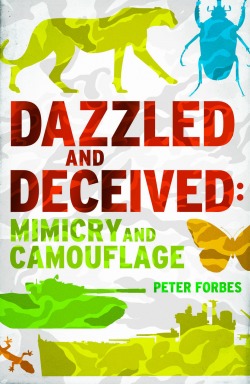by Peter Forbes
Yale University Press
 |
From Peter Forbes' website:
Nature has perfected the art of deception. Thousands of creatures all over the world - including butterflies, moths, fish, birds, insects and snakes - have honed and practiced camouflage over hundreds of millions of years. Imitating other animals or their surroundings, nature's fakers use mimicry to protect themselves, to attract and repel, to bluff and warn, to forage and to hide. The advantages of mimicry are obvious - but how does 'blind' nature do it? And how has humanity learnt to profit from nature's ploys?
Dazzled and Deceived tells the unique and fascinating story of mimicry and camouflage in science, art, warfare and the natural world. Discovered in the 1850s by the young English naturalists Henry Walter Bates and Alfred Russel Wallace in the Amazonian rainforest, the phenomenon of mimicry was seized upon as the first independent validation of Darwin's theory of natural selection. But mimicry and camouflage also created a huge impact outside the laboratory walls. Peter Forbes's cultural history links mimicry and camouflage to art, literature, military tactics and medical cures across the twentieth century, and charts its intricate involvement with the perennial dispute between evolution and creationism.
As Dazzled and Deceived unravels the concept of mimicry, Forbes introduces colourful stories and a dazzling cast of characters - Roosevelt, Picasso, Nabokov, Churchill, and Darwin himself, to name a few - whom its mystery influenced and enthralled. Illuminating and lively, Dazzled and Deceived sheds new light on the greatest quest: to understand the processes of life at its deepest level.
It's always a pleasure to receive a book for review, although I did wonder how relevant this book would be to those, such as myself, particularly interested in Lepidoptera. I was pleasantly surprised to find that the majority of links to the natural world use butterflies as their example, which I know is one of the reasons I was sent the book! I have to say, I found the book an easy read; the author has an engaging storytelling style that lays out crucial historical facts against a backdrop of the characters involved as we are led on a tour through the ages, from the Victorian era right up to the present day.
Not surpringly, the highlights of the book, for me, are those that focus on the natural world and, in particular, Lepidoptera! These highlights include a discussion of the early work of Henry Walter Bates and Alfred Russel Wallace, whose trips to the Amazon provided early insights into the value of mimicry where, most notably, mimics of Heliconiid butterflies were afforded some protection from predators. The resulting Batesian mimicry, named after Bates, of course provided evidence to support Darwin's theory of evolution by natural selection. The book goes further, introducing new characters along the way, such as Fritz Muller, whose Mullerian mimicry shows that different species, each of which is distasteful to birds and other predators, mimic each other so that the number of losses (due to predators who have yet to learn their lesson) of each butterfly species is reduced. Papilio dardanus provides another interesting example where different forms of offspring are produced to improve the chances of survival. These are just a few examples of a wonderful array of Lepidoptera-related topics that the book touches on.
Another theme of the book is our practical application of lessons learned from the natural world. For example, 6 of the 16 chapters of this 283-page book are dedicated to mimicry and camouflage during the world wars. I must admit, I found this particular discussion too long for my liking although I dare say that some readers would find this particular section the most appealing!
While I have several books that each lightly touch on the subject of mimicry and camouflage, this book conveniently pulls all of the different strands together, surely making this one of the most authoritative accounts of the subject; I know I will be referring back to the book for years to come. With Christmas coming up, I can highly recommend this as a stocking filler; you won't be disappointed.